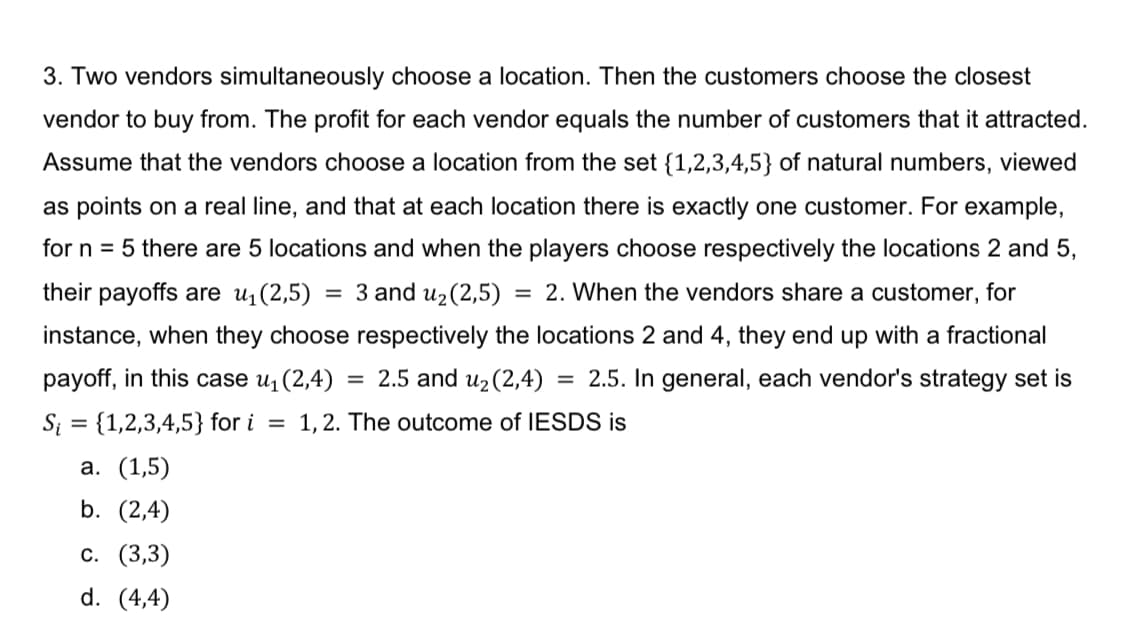3. Two vendors simultaneously choose a location. Then the customers choose the closest vendor to buy from. The profit for each vendor equals the number of customers that it attracted. Assume that the vendors choose a location from the set {1,2,3,4,5} of natural numbers, viewed as points on a real line, and that at each location there is exactly one customer. For example, for n = 5 there are 5 locations and when the players choose respectively the locations 2 and 5, their payoffs are u(2,5) = 3 and u2(2,5) = 2. When the vendors share a customer, for instance, when they choose respectively the locations 2 and 4, they end up with a fractional payoff, in this case u(2,4) : 2.5 and u2(2,4) 2.5. In general, each vendor's strategy set is Si = {1,2,3,4,5} for i 1, 2. The outcome of IESDS is
3. Two vendors simultaneously choose a location. Then the customers choose the closest vendor to buy from. The profit for each vendor equals the number of customers that it attracted. Assume that the vendors choose a location from the set {1,2,3,4,5} of natural numbers, viewed as points on a real line, and that at each location there is exactly one customer. For example, for n = 5 there are 5 locations and when the players choose respectively the locations 2 and 5, their payoffs are u(2,5) = 3 and u2(2,5) = 2. When the vendors share a customer, for instance, when they choose respectively the locations 2 and 4, they end up with a fractional payoff, in this case u(2,4) : 2.5 and u2(2,4) 2.5. In general, each vendor's strategy set is Si = {1,2,3,4,5} for i 1, 2. The outcome of IESDS is
Chapter8: Game Theory
Section: Chapter Questions
Problem 8.9P
Related questions
Question

Transcribed Image Text:3. Two vendors simultaneously choose a location. Then the customers choose the closest
vendor to buy from. The profit for each vendor equals the number of customers that it attracted.
Assume that the vendors choose a location from the set {1,2,3,4,5} of natural numbers, viewed
as points on a real line, and that at each location there is exactly one customer. For example,
for n = 5 there are 5 locations and when the players choose respectively the locations 2 and 5,
their payoffs are u(2,5) = 3 and u2(2,5)
= 2. When the vendors share a customer, for
%3D
instance, when they choose respectively the locations 2 and 4, they end up with a fractional
payoff, in this case u¡(2,4)
= 2.5 and uz(2,4)
= 2.5. In general, each vendor's strategy set is
Si = {1,2,3,4,5} for i
1, 2. The outcome of IESDS is
%3D
а. (1,5)
b. (2,4)
с. (3,3)
d. (4,4)
Expert Solution
This question has been solved!
Explore an expertly crafted, step-by-step solution for a thorough understanding of key concepts.
This is a popular solution!
Trending now
This is a popular solution!
Step by step
Solved in 2 steps with 10 images

Knowledge Booster
Learn more about
Need a deep-dive on the concept behind this application? Look no further. Learn more about this topic, economics and related others by exploring similar questions and additional content below.Recommended textbooks for you


Managerial Economics: A Problem Solving Approach
Economics
ISBN:
9781337106665
Author:
Luke M. Froeb, Brian T. McCann, Michael R. Ward, Mike Shor
Publisher:
Cengage Learning


Managerial Economics: A Problem Solving Approach
Economics
ISBN:
9781337106665
Author:
Luke M. Froeb, Brian T. McCann, Michael R. Ward, Mike Shor
Publisher:
Cengage Learning